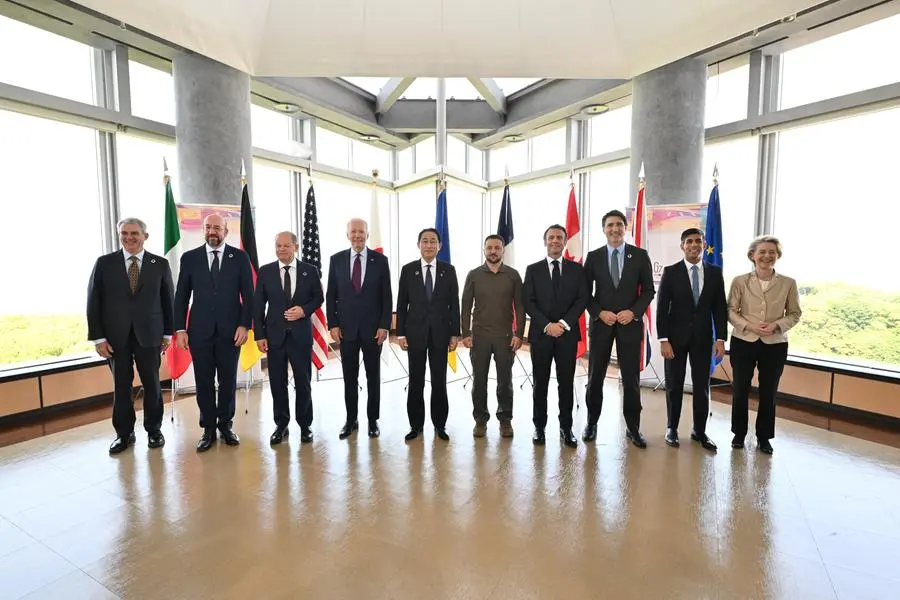PHOTO
Geopolitics dominated the just-concluded G7 summit in Hiroshima, where the most prominent participant was not a G7 leader, but Ukrainian President Volodymyr Zelensky. The leader of a country under threat of Russian nuclear attack visiting the Hiroshima Peace Memorial was the summit’s pivotal moment.
The choice of Hiroshima to host the summit was important for Prime Minister Fumio Kishida for two reasons. First, Kishida’s constituency is in Hiroshima. Hosting one of the most prominent international events in his hometown will boost his popularity there. Second, bringing world leaders to the city where the first atomic bomb was used is important for any Japanese politician, and resonates even more when Russian President Vladimir Putin’s nuclear threats are still echoing.
Kishida’s popularity had been declining since the start of his premiership in October 2021. His economic policy packages, such as “new capitalism” and “digital garden city,” have had only a lukewarm reception. Between July 2022 and January 2023, his approval rating plummeted from 59% to 33%, before rebounding to 46% in May 2023 as the summit approached.
The impact of the summit on Kishida’s popularity partly reflects a decisive shift in Japanese public sentiment towards a tighter security alignment with the United States. Faced with North Korean missiles frequently landing near Japan’s territorial waters off Hokkaido, and armed Chinese coastguard ships regularly entering its territorial waters off the Senkaku Islands, the US presence is more necessary than ever.
Likewise, the shift in South Korea from an anti-Japan administration to a pro-Japan administration has helped Kishida. South Korean President Yoon Suk Yeol bravely decided to honour the 1965 treaty that settled claims related to Japanese companies’ wartime use of forced labour. The countries’ tit-for-tat economic sanctions have ended, and bilateral visits by their leaders have resumed.
The Japanese public appears to support not only Kishida’s solidarity with the G7 on punishing Russia for its attack on Ukraine, but also his stern warnings to China and his efforts to establish increasingly friendly ties with South Korea. Diplomacy, not economic policy, underpins the rebound in Kishida’s popularity, and the Hiroshima summit was the icing on the cake. Kishida could decide to capitalise on his rising approval rating by calling a snap election soon.
While the economic impact of the Russian attack caused immediate problems for the European countries at this year’s G7 Summit, for Japan and Asia, the fighting in Ukraine still seems far away. Japan is not sending any military equipment to Ukraine, owing to a longstanding interpretation of the 1947 “peace” constitution.
The threats from China and North Korea are much more immediate, and Japan’s decisive alignment with the G7 in support of Ukraine reflects a realisation that what happened there – an unprovoked attack by a neighbouring country – could happen in South Korea, or Japan. Russia shattered the illusion that having a peace constitution is enough to prevent a military attack from a hostile neighbour. International law and the United Nations seem powerless in the face of an aggressor that is a permanent member of the United Nations Security Council.
Given Putin’s repeated nuclear threats, it is no surprise that Kishida brought the G7 leaders to the Hiroshima Peace Memorial Museum, which displays exhibits that reveal the hellish impact on people and physical structures caused by just one bomb. Russia’s behaviour in Ukraine has made the Hiroshima and Nagasaki nuclear disasters a portent with which the world must reckon.
Even so, the Japanese public’s support for Ukraine is somewhat surprising, given the country’s pacifist history since 1945. Nuclear disarmament movements in Japan were traditionally a mixture of two civil groups. One, comprising victims from Hiroshima and Nagasaki, maintained close ties with communist and socialist parties. The other, more idealistic, believes that abolishing all nuclear weapons will ultimately lead to global peace.
The former camp implicitly criticized the US for using nuclear bombs against Japanese civilians. When the leftist movement was strong from the 1950s to 1970s, a visit by a US president to Hiroshima was unthinkable. Only when the anti-nuclear movement became more non-partisan did a US president feel able to pay a visit to Hiroshima without feeling that the US was apologizing. And it didn’t happen until 2016.
Many people interpreted US President Barack Obama’s visit to Hiroshima and Japanese Prime Minister Abe Shinzō’s visit to Pearl Harbor as the two countries’ quiet closure of the “Pacific War” and the legacy of the nuclear attack. Today, Russia’s attack on Ukraine and its threat of using nuclear weapons has transformed Japan’s nuclear disarmament movement into an anti-Russian movement.
On the first day of the G7 Summit, leaders issued a report entitled “G7 Leaders’ Hiroshima Vision on Nuclear Disarmament.” The declaration is pragmatic, although the ultimate goal is idealistic: “achieving a world without nuclear weapons with undiminished security for all.” And it condemns Russia, whose “irresponsible nuclear rhetoric, undermining of arms control regimes, and stated intent to deploy nuclear weapons in Belarus are dangerous and unacceptable.”
The G7 Summit in Hiroshima achieved more than a powerful demonstration of the continuing solidarity between the G7 and Ukraine. It also enabled countries that have been sitting on the fence, most prominently India and Brazil, to grasp the real cost that Ukraine is paying and the threat the invasion poses as a precedent. For Kishida, the summit turned out to be a major political success. But the gathering’s geopolitical ramifications could turn out to be even more positive. — Project Syndicate
(Takatoshi Ito, a former Japanese deputy vice minister of finance, is a professor at the School of International and Public Affairs at Columbia University and a senior professor at the National Graduate Institute for Policy Studies in Tokyo.)
Copyright © 2022 Khaleej Times. All Rights Reserved. Provided by SyndiGate Media Inc. (Syndigate.info).





















